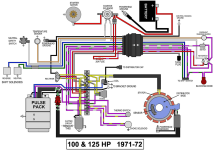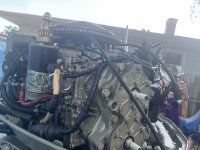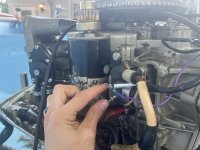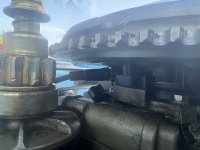CATALINAWineMixer
Cadet
- Joined
- Jul 12, 2023
- Messages
- 29
Can someone please show me where the diode is supposed to be installed to eliminate the voltage drop to the CDI pulse pack as indicated by Joe Reeves for 1972 Model Number 100293R 100hp (with Hall Effect Sensor)??
I have spark at the ignition coil but not to the plugs in the cylinders..
The starter solenoid has 4 terminals going from top to bottom with the solenoid attached to the block my engine is laid out as follows…
Top Large terminal - (+) from Battery & a 2-wire group (one is looped and used to contain a 20amp fuse which was deleted by previous owner) (The other leads to the terminal board, I installed the diode right before the terminal block in that red power wire that connects to the terminal block from the solenoid top terminal, I am not sure where else the diode would go that Joe Reeves mentioned as a fix for voltage drop)
Upper small terminal (S) - Keyswitch white wire
Lower small terminal (I) - white wire from Safety switch
Bottom Large terminal - Connects to starter Motor.
Starter motor is grounded only through being mounted to the block.
Starter Solenoid does not seem to be Grounded via a wire (my 1985 VRO 70hp had a ground wire on one of the smaller terminals for the starter solenoid)
What could be causing the non transfer of spark from coil to the plugs via the high tension leads??
I used a wire brush to clean the contacts inside the distributor cap so I can see the gold/brass contacts.
Plugs light up with a neon inline spark tester when cranking but will not gap when switched over to the gap tester.
Engine cranks strong, when I turn the key to the off position after trying to start it, I noticed the flywheel likes to pop back about an inch or so in the opposite direction. Is that normal or does that help with trying to diagnose the no start condition?
Please help me get back on the water before the season ends…
I have spark at the ignition coil but not to the plugs in the cylinders..
The starter solenoid has 4 terminals going from top to bottom with the solenoid attached to the block my engine is laid out as follows…
Top Large terminal - (+) from Battery & a 2-wire group (one is looped and used to contain a 20amp fuse which was deleted by previous owner) (The other leads to the terminal board, I installed the diode right before the terminal block in that red power wire that connects to the terminal block from the solenoid top terminal, I am not sure where else the diode would go that Joe Reeves mentioned as a fix for voltage drop)
Upper small terminal (S) - Keyswitch white wire
Lower small terminal (I) - white wire from Safety switch
Bottom Large terminal - Connects to starter Motor.
Starter motor is grounded only through being mounted to the block.
Starter Solenoid does not seem to be Grounded via a wire (my 1985 VRO 70hp had a ground wire on one of the smaller terminals for the starter solenoid)
What could be causing the non transfer of spark from coil to the plugs via the high tension leads??
I used a wire brush to clean the contacts inside the distributor cap so I can see the gold/brass contacts.
Plugs light up with a neon inline spark tester when cranking but will not gap when switched over to the gap tester.
Engine cranks strong, when I turn the key to the off position after trying to start it, I noticed the flywheel likes to pop back about an inch or so in the opposite direction. Is that normal or does that help with trying to diagnose the no start condition?
Please help me get back on the water before the season ends…























